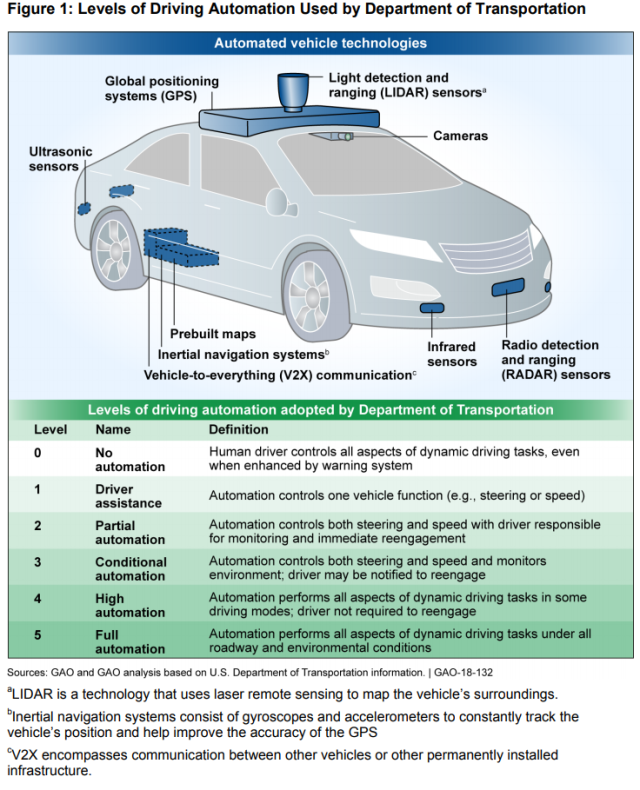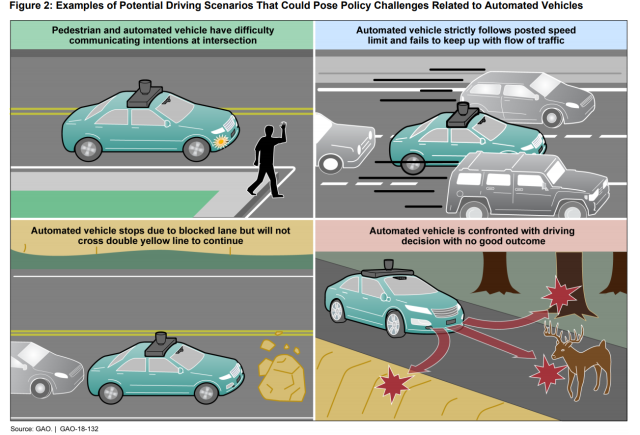Who is in the Driver’s Seat?
 Vehicles with Level 1 and Level 2 automation—such as adaptive cruise control or lane departure assistance and automated parking—are already on the road. Automakers and technology firms are investing heavily in developing Levels 3, 4, and 5 vehicles, which will perform with increasing autonomy. These vehicles are currently on public roads in test scenarios and some automakers plan to release cars that control all aspects of driving in certain conditions as early as 2021.
Promises and perils
The Transportation Department’s National Highway Traffic Safety Administration has calculated that 94% of all crashes are tied to human error. Many observers believe automated vehicle technologies could save lives by reducing these errors and could offer other benefits as well, such as reducing traffic congestion and expanding mobility for people with physical limitations.
For these benefits to be realized, policymakers must confront an array of challenges, including:
Vehicles with Level 1 and Level 2 automation—such as adaptive cruise control or lane departure assistance and automated parking—are already on the road. Automakers and technology firms are investing heavily in developing Levels 3, 4, and 5 vehicles, which will perform with increasing autonomy. These vehicles are currently on public roads in test scenarios and some automakers plan to release cars that control all aspects of driving in certain conditions as early as 2021.
Promises and perils
The Transportation Department’s National Highway Traffic Safety Administration has calculated that 94% of all crashes are tied to human error. Many observers believe automated vehicle technologies could save lives by reducing these errors and could offer other benefits as well, such as reducing traffic congestion and expanding mobility for people with physical limitations.
For these benefits to be realized, policymakers must confront an array of challenges, including:
- assuring that automated vehicles interact safely with other road users, including pedestrians and cyclists;
- adapting infrastructure to automated vehicles; and
- addressing questions about how data generated by automated vehicles can be used, an issue explored in another report on vehicle data privacy.
 Steering the future of driverless cars
The Department of Transportation has made some initial efforts to address these challenges by:
Steering the future of driverless cars
The Department of Transportation has made some initial efforts to address these challenges by:
- issuing guidance in 2017 that provides technical assistance for states and suggests a framework for industry-led safety training, and
- conducting defect investigations and pursuing recalls of some driver-assistance technologies through its National Highway Traffic Safety Administration.
- Questions on the content of this post? Contact Susan Fleming at FlemingS@gao.gov.
- Comments on GAO’s WatchBlog? Contact blog@gao.gov.

GAO's mission is to provide Congress with fact-based, nonpartisan information that can help improve federal government performance and ensure accountability for the benefit of the American people. GAO launched its WatchBlog in January, 2014, as part of its continuing effort to reach its audiences—Congress and the American people—where they are currently looking for information.
The blog format allows GAO to provide a little more context about its work than it can offer on its other social media platforms. Posts will tie GAO work to current events and the news; show how GAO’s work is affecting agencies or legislation; highlight reports, testimonies, and issue areas where GAO does work; and provide information about GAO itself, among other things.
Please send any feedback on GAO's WatchBlog to blog@gao.gov.
